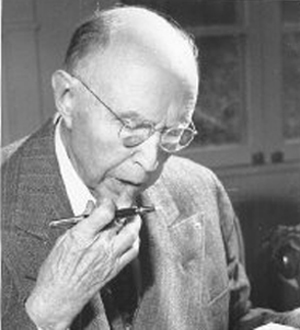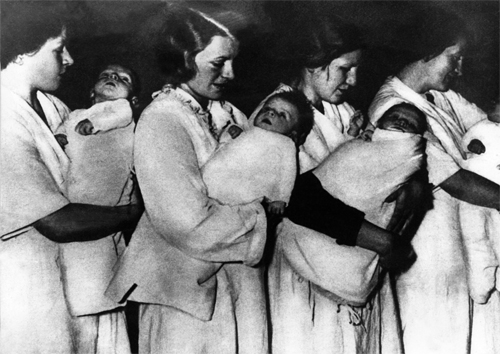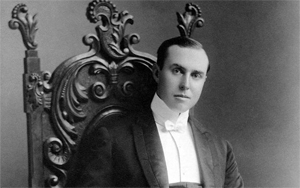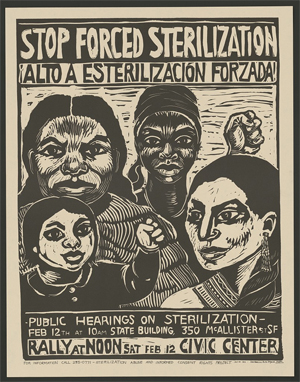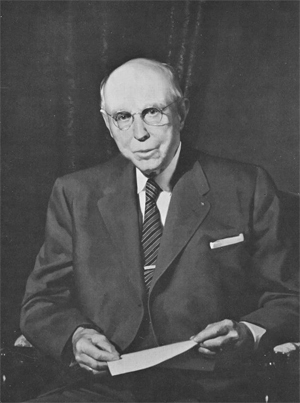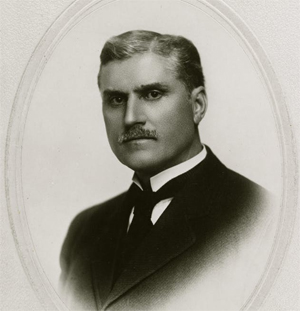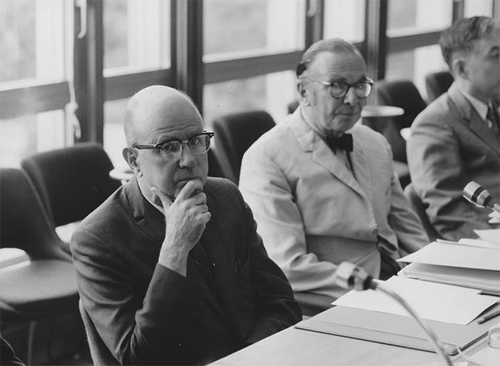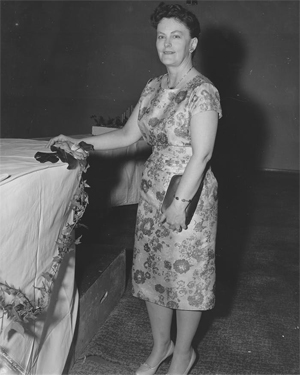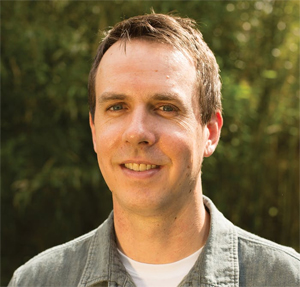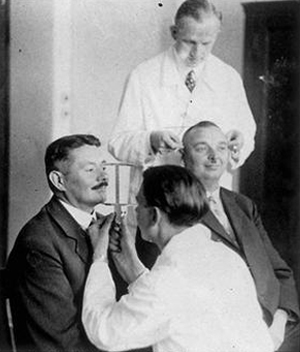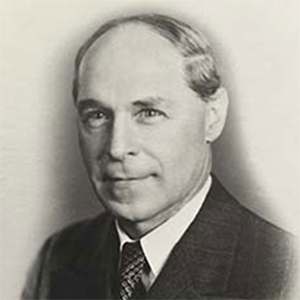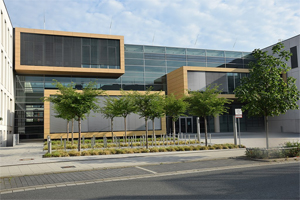Andrew Carnegie
by Wikipedia
Accessed: 3/30/20
The Carnegie Institution continued to back eugenics long after its executives became convinced it was a worthless nonscience based on shabby data, and years after they concluded that Harry Hamilton Laughlin himself was a sham.
Laughlin and eugenics in general had become the butt of jokes and the object of reprehension as far back as 1912, when the world learned that its proponents planned to sterilize millions in America and millions more in other nations. Scientists from other disciplines ridiculed the movement as well. Despite the widespread derision, eugenics persevered as a science under siege, battling back for years, fortified by its influential patrons, the power of prejudice and the big money of Carnegie. But the Carnegie Institution's patience began to erode as early as 1922, when Laughlin became a public font of racist ideology during the Congressional immigration restriction hearings. [9]
Carnegie president John C. Merriam continued to be embarrassed by Laughlin's immigration rantings throughout the 1920s. But he tolerated them for the greater agenda of the eugenics movement. However, Laughlin struck a particular nerve in the spring of 1928, while Merriam and a U.S. government official were touring Mexican archaeology sites. During the tour, Mexican newspapers splashed a story that Merriam's Carnegie Institution was proposing that Congress severely limit immigration of Mexicans into the United States. It was Laughlin who prompted the story. [10]
Merriam immediately instructed Davenport to muzzle Laughlin. "He [Merriam] feels especially that you ought not go further," Davenport wrote Laughlin, "... helping the [House] committee on a definition of who may be acceptable as immigrants to the United States from Spanish America. The Spanish Americans are very sensitive on this matter .... It will not do for the Carnegie Institution of Washington, or its officers, to take sides in this political question." Anticipating Laughlin's predictable argument, Davenport continued, "I know you regard it properly as more than a political question and as a eugenical question -- but it is in politics now, and that means that the institution has to preserve a neutrality." [11]
Yet Laughlin did nothing to restrict his vocal activities. By the end of 1928, Merriam convened an internal committee to review the value of the Eugenics Record Office. In early February of 1929, the committee inspected the Cold Spring Harbor facility and concluded that the accumulation of index cards, trait records and family trees amounted to little more than clutter. They "are of value only to the individual compiling them," the committee wrote, and even then "in most cases they decrease in importance in direct proportion to their age." Some of the files were almost two decades old, and all of them reflected nineteenth-century record-keeping habits now obsolete. The mass of records yielded much private information about individuals and their families, but little hard knowledge on heredity. [12]
Nonetheless, with Davenport and Laughlin lobbying to continue their work, the panel rejected any "radical move, such as relegating them [the files] to dead storage." Instead, Carnegie officials decided a closer affiliation with the Eugenics Research Association [The ERA was affiliated with the American Association for the Advancement of Science (fittingly through Section F: "The Zoological Sciences") and had two seats on the Council of the AAAS.] would help the ERO achieve some approximation of genuine science. Hence the Carnegie Institution would continue to operate the ERO under Carnegie's Department of Genetics. [13]
Genetics, however, was not the emphasis at Cold Spring Harbor. Laughlin and his ERO continued their race-based political agitation unabated. Moreover, once Hitler rose to power in 1933, Laughlin forged the ERO, the ERA and Eugenical News into a triumvirate of pro-Nazi agitation. But things changed when Davenport retired in June of 1934. Laughlin lost his greatest internal sponsor, and with Davenport out of power, Carnegie officials in Washington quickly began to move against Laughlin. They pointedly questioned his race science and indeed the whole concept of eugenics in a world where the genuine science of genetics was now emerging.
Carnegie officials first focused on Eugenical News, which had become a compendium of American raceology and Nazi propaganda. Although Eugenical News was published out of the Carnegie facilities at the ERO, by a Carnegie scientist, and functioned as the official voice of Carnegie's eugenic operations, the Carnegie Institution did not legally own or control Eugenical News. It was Laughlin's enterprise. Carnegie wanted an immediate change and made this clear to Laughlin. [14]
Laughlin became very protective. He had always chosen what would and would not run in Eugenical News, and he even authored much of the text. In a September 11, 1934, letter to Davenport's replacement, Albert F. Blakeslee, Laughlin rebuffed attempts to corral Eugenical News, defensively insisting, "In this formative period of making eugenics into a science, the ideals of the Eugenics Record Office, of the Eugenics Research Association, of the International Congresses and Exhibits of Eugenics, and of the Eugenical News are identical. I feel that the position of the Eugenical News as a scientific journal is quite unique, in that eugenics is a new science, and that the trend and rate of its development, and its ultimate character, will be influenced substantially by the Eugenical News." [15]
Laughlin made clear to Carnegie officials that they simply could not control Eugenical News, because it was legally the property of the Eugenics Research Association -- and Laughlin was the secretary of the ERA. To drive home his point, a Laughlin memo defiantly included typed-in excerpts from committee reports and letters to the printer, plus sample issues going back to 1916 -- all demonstrating the ERA's legal authority over Eugenical News. "I feel that the Institution should go into the matter thoroughly," insisted Laughlin, "and make a clean-cut and definite ruling concerning the relationship of the Carnegie Institution (represented by the Eugenics Record Office) to the Eugenical News." [16]
By now, Carnegie felt it was again time to formally revisit the worth of Laughlin and eugenics. A new advisory committee was assembled, spearheaded by archaeologist A.V. [Alfred Vincent] Kidder. He began assembling information on Laughlin's activities, and Laughlin was only too happy to cooperate, almost boastfully inundating Kidder with folder after folder of material. With Davenport in retirement, Laughlin undoubtedly felt he was heir to Cold Spring Harbor's throne. He sent Washington a passel of demands about revamping Cold Spring Harbor's administrative structure, renovations of its property and new budget requests for 1935. [17]
Kidder was not encouraging. He wrote back, "I think I ought to tell you that I feel quite certain that the administrative and financial changes which you advocate are extremely unlikely, in my opinion, to be carried into effect in 1935." Kidder was virtually besieged with Laughlin's written and printed submissions to support his requests for a sweeping expansion of the ERO. On November 1, 1934, Kidder acknowledged, "I am at present reviewing all the correspondence and notes in my possession relative to the whole Cold Spring Harbor situation and in the course of a few days I shall prepare a memorandum for Dr. Merriam." But within two days, Kidder conceded that he was overwhelmed. "I have read all the material you sent me with close attention," he wrote Laughlin. "I have also read all the Year Book reports of the Eugenics Record Office .... I am now trying to correlate all this information in what passes for my brain." [18]
On Sunday, June 16 and Monday, June 17, 1935, the advisory committee led by Kidder visited Cold Spring Harbor, touring both the ERO and the adjacent Carnegie Station for Experimental Evolution. Laughlin's residence, provided by the Carnegie Institution, was one of the buildings in the compound, and Mrs. Laughlin graciously prepared Sunday lunch and Monday dinner for the delegation. The men found her hospitality delightful, and Laughlin's presentations exhaustive. But after a thorough examination, the advisory committee concluded that the Eugenics Record Office was a worthless endeavor from top to bottom, yielding no real data, and that eugenics itself was not science but rather a social propaganda campaign with no discernible value to the science of either genetics or human heredity. [19]
Almost a million ERO records assembled on individuals and families were "unsatisfactory for the scientific study of human genetics," the advisory committee explained, "because so large a percentage of the questions concern ... traits, such as 'self-respect,' 'holding a grudge,' 'loyalty,' [and] 'sense of humor,' which can seldom truly be known to anyone outside an individual's close associates; and which will hardly ever be honestly recorded, even were they measurable, by an associate or by the individual concerned." [20]
While much ERO attention was devoted to meaningless personality traits, key physical traits were being recorded so sloppily by "untrained persons" and "casually interested individuals" that the advisory committee concluded this data was also "relatively worthless for genetic study." The bottom line: a million index cards, some 35,000 files, and innumerable other records merely occupied "a great amount of the small space available ... and, worst of all, they do not appear to us really to permit satisfactory use of the data." [21]
The advisory committee recommended that all genealogical and eugenic tracking activities cease, and that the cards be placed in storage until whatever bits of legitimate heredity data they contained could be properly extracted and analyzed using an IBM punch card system. A million index cards had accumulated during some two decades, but because of the project's starting date in 1910 and Laughlin's unscientific methodology, the data had never been analyzed by IBM's data processing system. This fact only solidified the advisory committee's conclusion that the Eugenics Record Office was engaged in mere biological gossip backed up by reams of worthless documents. The advisory committee doubted that the demographic muddle would "ever be of value," and added its hope that "never again ... should records be allowed to bank up to such an extent that they cannot be kept currently analyzed."[22]
The advisory committee vigorously urged that "The Eugenics Record Office should engage in no new undertaking; and that all current activities should be discontinued save for Dr. Laughlin's work in preparation of his final report upon the Race Horse investigation." Moreover, the advisory committee emphasized, "The Eugenics Record Office should devote its entire energies to pure research divorced from all forms of propaganda and the urging or sponsoring of programs for social reform or race betterment such as sterilization, birth-control, inculcation of race or national consciousness, restriction of immigration, etc. Hence it might be well for the personnel of the Office to discontinue connection with the Eugenical News." Committee members concluded, "Eugenics is by generally accepted definition and understanding not a science." They insisted that any further involvement with Cold Spring Harbor be devoid of the word eugenics and instead gravitate to the word genetics. [23]
Geneticist L. C. Dunn, a member of the advisory committee traveling in Europe at the time, added his opinion in a July 3, 1935, letter, openly copied to Laughlin. Dunn was part of a growing school of geneticists demanding a clean break between eugenics and genetics. "With genetics," advised Dunn, "its relations have always been close, although there have been distinct signs of cleavage in recent years, chiefly due to the feeling on the part of many geneticists that eugenical research was not always activated by purely disinterested scientific motives, but was influenced by social and political considerations tending to bring about too rapid application of incompletely proved theses. In the United States its [the eugenics movement's] relations with medicine have never been close, the applications having more often been made through sociology than through medicine, although the basic problems involved are biological and medical ones." [24]
Dunn wondered if it wasn't time to shut down Cold Spring Harbor altogether and move the operation to a university where such an operation could collaborate with other disciplines. "There would seem to me to be no peculiar advantages in the Cold Spring Harbor location." As it stood, '''Eugenics' has come to mean an effort to foster a program of social improvement rather than an effort to discover facts." In that regard, Dunn made a clear comparison to Nazi excesses. "I have just observed in Germany," he wrote, "some of the consequences of reversing the order as between program and discovery. The incomplete knowledge of today, much of it based on a theory of the state, which has been influenced by the racial, class and religious prejudices of the group in power, has been embalmed in law, and the avenues to improvement in the techniques of improving the population have been completely closed." [25]
Dunn's July 3 letter continued with even more pointed comparisons to Nazi Germany. "The genealogical record offices have become powerful agencies of the [German] state," he wrote, "and medical judgments even when possible, appear to be subservient to political purposes. Apart from the injustices in individual cases, and the loss of personal liberty, the solution of the whole eugenic problem by fiat eliminates any rational solution by free competition of ideas and evidence. Scientific progress in general seems to have a very dark future. Although much of this is due to the dictatorship, it seems to illustrate the dangers which all programs run which are not continually responsive to new knowledge, and should certainly strengthen the resolve which we generally have in the U.S. to keep all agencies which contribute to such questions as free as possible from commitment to fixed programs." [26]
Carnegie's advisory committee could not have been more clear: eugenics was a dangerous sham, the ERO was a worthless and expensive undertaking devoid of scientific value, and Laughlin was purely political. But as Hitler rose and the situation of the Jews in Europe worsened, and the plight of refugees seeking entry into the United States became ever more desperate, the Carnegie Institution elected to ignore its own findings about Cold Spring Harbor and continue its economic and political support for Laughlin and his enterprises. Shortly after Merriam reviewed the advisory committee's conclusions, the Reich passed the Nuremberg Laws in September of 1935. Those of Jewish ancestry were stripped of their civil rights. Laughlin, Eugenical News and the Cold Spring Harbor eugenics establishment propagandized that the laws were merely sound science. Eugenical News even gave senior Nazi leaders a platform to justify their decrees. The Carnegie Institution still took no action against its Cold Spring Harbor enterprise.
In 1936, the brutal Nazi concentration camps multiplied. Systematic Jewish pauperization accelerated. Jews continued fleeing Germany in terror, seeking entry anywhere. But American consulates refused them visas. In the face of the humanitarian crisis, Laughlin continued to advise the State Department and Congress to enforce stiff eugenic immigration barriers against Jews and other desperate refugees. The Carnegie Institution still took no action against its Cold Spring Harbor enterprise. [27]
In 1937, Nazi street violence escalated and Germany increasingly vowed to extend its master race to all of Europe -- and to completely cleanse the continent of Jews. Laughlin, Eugenical News and the eugenics establishment continued to agitate in support of the Reich's goals and methods, and even distributed the anti-Semitic Nazi film, Erbkrank. The Carnegie Institution still took no action against its Cold Spring Harbor enterprise. [28]One of hard propaganda Nazi films produced by the Office of Racial Policy in the National Socialist Racial and Political Office meant to warn the greater public about the dangers and costs posed by mentally ill and mentally retarded people.
"Erbkrank” [The Hereditary Defective] was directed by Herbert Gerdes. It was one of six propagandistic movies produced by the NSDAP, Reichsleitung, Rassenpolitisches Amt or the Office of Racial Policy, from 1935 to 1937 to demonize people in Nazi Germany diagnosed with mental illness and mental retardation.
The goal was to gain public support for the T4 Euthanasia Program then in the works. This film, as the others, was made with actual footage of patients in Nazi German psychiatric institutions.
Adolf Hitler reportedly liked the film so much that he encouraged the production of the full-length film "Opfer der Vergangenheit: Die Sünde wider Blut und Rasse” (English: Victims of the Past: The Sin against Blood and Race). In 1937, Erbkrank was reportedly showing in nearly all Berlin film theaters.
-- Erbkrank (1936), by Tiergartenstrasse 4 Association
In 1938, as hundreds of thousands of new refugees appeared, an emergency intergovernmental conference was convened at Evian, France. It was fruitless. Germany then decreed that all Jewish property was to be registered, a prelude to comprehensive liquidation and seizure. In November, Kristallnacht shocked the world. Nazi agitation was now spreading into every country in Europe. Austria had been absorbed into the Reich. Hitler threatened to devour other neighboring countries as well. Laughlin, Eugenical News and the eugenics establishment still applauded the Hitler campaign. By the end of 1938, however, the Carnegie Institution realized it could not delay action much longer. [29]
On January 4, 1939, newly installed Carnegie president Vannevar Bush put Laughlin on notice that while his salary for the year was assured, Bush was not sure how much funding the ERO would receive -- if any. At the same time, Jews from across Europe continued to flee the Continent, many begging to enter America because no other nation would take them. In March of 1939, the Senate Immigration Committee asked Bush if Laughlin could appear for another round of testimony to support restrictive "remedial legislation." Bush permitted Laughlin to appear, and only asked him to limit his unsupportable scientific assertions. But Laughlin was not prohibited from again promoting eugenic and racial barriers as the best basis for immigration policy. Indeed, the Carnegie president reminded him, "One has to express opinions when he appears in this sort of inquiry, and I believe that yours will be found to be a conservative and well-founded estimate of the situation facing the Committee." Bush added that he had personally reviewed Laughlin's prior testimony and felt it was "certainly well handled and valuable." [30]
After testifying, Laughlin received a postcard at the Carnegie Institution in Washington from an irate citizen in Los Angeles. "As an American descendant of Americans for over 300 years, I'd like to learn what prompted you to supply [the Senate Immigration Committee] ... with so much material straight from Hitler's original edition of Mein Kampf." [31]
At about this time, Laughlin was also permitted to testify before the Special Committee on Immigration and Naturalization of the New York State Chamber of Commerce. In May of 1939, Laughlin's report, Immigration and Conquest, was published under the imprimatur of the New York State Chamber of Commerce and "Harry H. Laughlin, Carnegie Institution of Washington." The 267-page document, filled with raceological tenets, claimed that America would soon suffer "conquest by settlement and reproduction" through an infestation of defective immigrants. As a prime illustration, Laughlin offered "The Parallel Case of the House Rat," in which he traced rodent infestation from Europe to the rats' ability "to travel in sailing ships." [32]
Laughlin then explained, in a section entitled "The Jew as an Immigrant Into the United States," that Jews were being afforded too large a quota altogether because they were being improperly considered by their nationality instead of as a distinct racial type. By Laughlin's calculations, no more than six thousand Jews per year ought to be able to enter the United States under the existing national quota system -- the system he helped organize a half-decade earlier -- but many more were coming in because they were classified as German or Russian or Polish instead of Jewish. He asked that Jews in the United States "assimilate" properly and prove their "loyalty to the American institutions" was "greater than their loyalty to Jews scattered through other nations." Immigration and Conquest's precepts were in many ways identical to Nazi principles. Laughlin and the ERO proudly sent a copy to Reich Interior Minister Wilhelm Frick, as well as to other leading Nazis, including Verschuer, Lenz, Ploetz and even Rudin at a special address care of a university in occupied Czechoslovakia. [33]
In late 1938, the Carnegie Institution finally disengaged from Eugenical News. The publication became a quarterly completely under the aegis of the American Eugenics Society, published out of AES offices in Manhattan, with a new editorial committee that did not include Laughlin or any other Carnegie scientist. The first issue of the reorganized publication was circulated in March of 1939. Shortly thereafter, the Carnegie Institution formalized Laughlin's retirement, effective at the end of the year. On September 1, 1939, the Nazis invaded Poland, igniting World War II. Highly publicized atrocities against Polish Jews began at once, shocking the world.[/b] Efforts by Laughlin in the final months of 1939 to find a new sponsor for the ERO were unsuccessful. On December 31, 1939, Laughlin officially retired. The Eugenics Record Office was permanently closed the same day. [34]
-- War Against the Weak: Eugenics and America's Campaign to Create a Master Race, by Edwin Black
Andrew Carnegie
Carnegie in 1913
Born: November 25, 1835, Dunfermline, Fife, Scotland
Died: August 11, 1919 (aged 83), Lenox, Massachusetts, U.S.
Resting place: Sleepy Hollow Cemetery, Sleepy Hollow, New York, U.S.
Occupation: Industrialist, Philanthropist
Known for: Founding and leading the Carnegie Steel Company; Founding the Carnegie Library, Carnegie Institution for Science, Carnegie Corporation of New York, Carnegie Endowment for International Peace, Carnegie Mellon University, Carnegie Trust for the Universities of Scotland, and the Carnegie Hero Fund
Net worth: US$372 billion in 2014 dollars[1]
Political party: Republican[2]
Spouse(s): Louise Whitfield (m. 1887)
Children: Margaret Carnegie Miller
Parent(s): William Carnegie; Margaret Morrison Carnegie
Relatives: Thomas M. Carnegie (Brother) George Lauder (1st Cousin) George Lauder, Sr. (Uncle)
[x]
Carnegie as he appears in the National Portrait Gallery in Washington, D.C.
Andrew Carnegie /kɑːrˈneɪɡi/ kar-NAY-gee[note 1] (November 25, 1835 – August 11, 1919) was a Scottish-American industrialist, and philanthropist. Carnegie led the expansion of the American steel industry in the late 19th century and became one of the richest Americans in history.[4] He became a leading philanthropist in the United States and in the British Empire. During the last 18 years of his life, he gave away $350 million (conservatively $65 billion in 2019 dollars, based on percentage of GDP) to charities, foundations, and universities – almost 90 percent of his fortune.[5] His 1889 article proclaiming "The Gospel of Wealth" called on the rich to use their wealth to improve society, and stimulated a wave of philanthropy.
Carnegie was born in Dunfermline, Scotland, and immigrated to the United States with his parents in 1848 at age 12. Carnegie started work as a telegrapher, and by the 1860s had investments in railroads, railroad sleeping cars, bridges, and oil derricks. He accumulated further wealth as a bond salesman, raising money for American enterprise in Europe. He built Pittsburgh's Carnegie Steel Company, which he sold to J. P. Morgan in 1901 for $303,450,000.[6] It became the U.S. Steel Corporation. After selling Carnegie Steel, he surpassed John D. Rockefeller as the richest American for the next several years.
Carnegie devoted the remainder of his life to large-scale philanthropy, with special emphasis on local libraries, world peace, education, and scientific research. With the fortune he made from business, he built Carnegie Hall in New York, NY, and the Peace Palace and founded the Carnegie Corporation of New York, Carnegie Endowment for International Peace, Carnegie Institution for Science, Carnegie Trust for the Universities of Scotland, Carnegie Hero Fund, Carnegie Mellon University, and the Carnegie Museums of Pittsburgh, among others.
Biography
[x]
Birthplace of Andrew Carnegie in Dunfermline, Scotland
Andrew Carnegie was born to Margaret Morrison Carnegie and William Carnegie in Dunfermline, Scotland, in a typical weaver's cottage with only one main room, consisting of half the ground floor, which was shared with the neighboring weaver's family.[7] The main room served as a living room, dining room and bedroom.[7] He was named after his paternal grandfather.[7] In 1836, the family moved to a larger house in Edgar Street (opposite Reid's Park), following the demand for more heavy damask, from which his father benefited.[7] He was educated at the Free School in Dunfermline, which had been a gift to the town by the philanthropist Adam Rolland of Gask.[8]
Carnegie's maternal uncle, George Lauder, Sr., a Scottish political leader, deeply influenced him as a boy by introducing him to the writings of Robert Burns and historical Scottish heroes such as Robert the Bruce, William Wallace, and Rob Roy. Lauder's son, also named George Lauder, grew up with Carnegie and would become his business partner. When Carnegie was thirteen, his father had fallen on very hard times as a handloom weaver; making matters worse, the country was in starvation. His mother helped support the family by assisting her brother (a cobbler), and by selling potted meats at her "sweetie shop", leaving her as the primary breadwinner.[9] Struggling to make ends meet, the Carnegies then decided to borrow money from George Lauder, Sr.[10] and move to Allegheny, Pennsylvania, in the United States in 1848 for the prospect of a better life.[11] Carnegie's migration to America would be his second journey outside Dunfermline – the first being an outing to Edinburgh to see Queen Victoria.[12]
In September 1848, Carnegie arrived with his family at their new prosperous home. Allegheny was rapidly populating in the 1840s, growing from around 10,000 to 21,262 residents.[13] The city was very industrial and produced many products including wool and cotton cloth. The "Made in Allegheny" label used on these and other diversified products was becoming more and more popular.[14] For his father, the promising circumstances still did not provide him any good fortune. Dealers were not interested in selling his product, and he himself struggled to sell it on his own.[15] Eventually, the father and son both received job offers at the same Scottish-owned cotton mill, Anchor Cotton Mills. Carnegie's first job in 1848 was as a bobbin boy, changing spools of thread in a cotton mill 12 hours a day, 6 days a week in a Pittsburgh cotton factory. His starting wage was $1.20 per week ($35 by 2019 inflation).[16]
His father quit his position at the cotton mill soon after, returning to his loom and removing him as breadwinner once again.[13] But Carnegie attracted the attention of John Hay, a Scottish manufacturer of bobbins, who offered him a job for $2.00 per week ($59 by 2019 inflation).[17] In his autobiography, Carnegie speaks of his past hardships he had to endure with this new job.
Soon after this Mr. John Hay, a fellow Scotch manufacturer of bobbins in Allegheny City, needed a boy, and asked whether I would not go into his service. I went, and received two dollars per week; but at first the work was even more irksome than the factory. I had to run a small steam-engine and to fire the boiler in the cellar of the bobbin factory. It was too much for me. I found myself night after night, sitting up in bed trying the steam gauges, fearing at one time that the steam was too low and that the workers above would complain that they had not power enough, and at another time that the steam was too high and that the boiler might burst.[18]
Railroads
[x]
Carnegie age 16, with brother Thomas
In 1849,[19] Carnegie became a telegraph messenger boy in the Pittsburgh Office of the Ohio Telegraph Company, at $2.50 per week ($77 by 2019 inflation)[20] following the recommendation of his uncle. He was a hard worker and would memorize all of the locations of Pittsburgh's businesses and the faces of important men. He made many connections this way. He also paid close attention to his work, and quickly learned to distinguish the differing sounds the incoming telegraph signals produced. He developed the ability to translate signals by ear, without using the paper slip,[21] and within a year was promoted to operator. Carnegie's education and passion for reading was given a boost by Colonel James Anderson, who opened his personal library of 400 volumes to working boys each Saturday night.[22] Carnegie was a consistent borrower and a "self-made man" in both his economic development and his intellectual and cultural development. He was so grateful to Colonel Anderson for the use of his library that he "resolved, if ever wealth came to me, [to see to it] that other poor boys might receive opportunities similar to those for which we were indebted to the noble man".[23] His capacity, his willingness for hard work, his perseverance and his alertness soon brought him opportunities.
Starting in 1853, when Carnegie was around 18 years old, Thomas A. Scott of the Pennsylvania Railroad Company employed him as a secretary/telegraph operator at a salary of $4.00 per week ($123 by 2019 inflation). Carnegie accepted the job with the railroad as he saw more prospects for career growth and experience there than with the telegraph company.[9] At age 24, Scott asked Carnegie if he could handle being superintendent of the Western Division of the Pennsylvania Railroad.[24] On December 1, 1859, Carnegie officially became superintendent of the Western Division. Carnegie then hired his sixteen-year-old brother, Tom, to be his personal secretary and telegraph operator. Not only did Carnegie hire his brother, but he also hired his cousin, Maria Hogan, who became the first female telegraph operator in the country.[25] As superintendent Carnegie made a salary of fifteen hundred dollars a year ($43,000 by 2019 inflation).[24] His employment by the Pennsylvania Railroad Company would be vital to his later success. The railroads were the first big businesses in America, and the Pennsylvania was one of the largest of them all. Carnegie learned much about management and cost control during these years, and from Scott in particular.[9]
Scott also helped him with his first investments. Many of these were part of the corruption indulged in by Scott and the Pennsylvania's president, John Edgar Thomson, which consisted of inside trading in companies that the railroad did business with, or payoffs made by contracting parties "as part of a quid pro quo".[26] In 1855, Scott made it possible for Carnegie to invest $500 in the Adams Express, which contracted with the Pennsylvania to carry its messengers. The money was secured by his mother's placing of a $600 mortgage on the family's $700 home, but the opportunity was available only because of Carnegie's close relationship with Scott.[26][27] A few years later, he received a few shares in Theodore Tuttle Woodruff's sleeping car company, as a reward for holding shares that Woodruff had given to Scott and Thomson, as a payoff. Reinvesting his returns in such inside investments in railroad-related industries: (iron, bridges, and rails), Carnegie slowly accumulated capital, the basis for his later success. Throughout his later career, he made use of his close connections to Thomson and Scott, as he established businesses that supplied rails and bridges to the railroad, offering the two men a stake in his enterprises.
1860–1865: The Civil War
Before the Civil War, Carnegie arranged a merger between Woodruff's company and that of George Pullman, the inventor of a sleeping car for first class travel, which facilitated business travel at distances over 500 miles (800 km). The investment proved a success and a source of profit for Woodruff and Carnegie. The young Carnegie continued to work for the Pennsylvania's Tom Scott, and introduced several improvements in the service.[28]
In spring 1861, Carnegie was appointed by Scott, who was now Assistant Secretary of War in charge of military transportation, as Superintendent of the Military Railways and the Union Government's telegraph lines in the East. Carnegie helped open the rail lines into Washington D.C. that the rebels had cut; he rode the locomotive pulling the first brigade of Union troops to reach Washington D.C. Following the defeat of Union forces at Bull Run, he personally supervised the transportation of the defeated forces. Under his organization, the telegraph service rendered efficient service to the Union cause and significantly assisted in the eventual victory. Carnegie later joked that he was "the first casualty of the war" when he gained a scar on his cheek from freeing a trapped telegraph wire.
Defeat of the Confederacy required vast supplies of munitions, as well as railroads (and telegraph lines) to deliver the goods. The war demonstrated how integral the industries were to American success.
Keystone Bridge Company
In 1864, Carnegie was one of the early investors in the Columbia Oil Company in Venango County, Pennsylvania.[29] In one year, the farm yielded over $1,000,000 in cash dividends, and petroleum from oil wells on the property sold profitably. The demand for iron products, such as armor for gunboats, cannons, and shells, as well as a hundred other industrial products, made Pittsburgh a center of wartime production. Carnegie worked with others in establishing a steel rolling mill, and steel production and control of industry became the source of his fortune. Carnegie had some investments in the iron industry before the war.
After the war, Carnegie left the railroads to devote his energies to the ironworks trade. Carnegie worked to develop several ironworks, eventually forming the Keystone Bridge Works and the Union Ironworks, in Pittsburgh. Although he had left the Pennsylvania Railroad Company, he remained connected to its management, namely Thomas A. Scott and J. Edgar Thomson. He used his connection to the two men to acquire contracts for his Keystone Bridge Company and the rails produced by his ironworks. He also gave stock to Scott and Thomson in his businesses, and the Pennsylvania was his best customer. When he built his first steel plant, he made a point of naming it after Thomson. As well as having good business sense, Carnegie possessed charm and literary knowledge. He was invited to many important social functions, which Carnegie exploited to his advantage.[30]
[x]
Carnegie, c. 1878
Carnegie believed in using his fortune for others and doing more than making money. He wrote:
I propose to take an income no greater than $50,000 per annum! Beyond this I need ever earn, make no effort to increase my fortune, but spend the surplus each year for benevolent purposes! Let us cast aside business forever, except for others. Let us settle in Oxford and I shall get a thorough education, making the acquaintance of literary men. I figure that this will take three years' active work. I shall pay especial attention to speaking in public. We can settle in London and I can purchase a controlling interest in some newspaper or live review and give the general management of it attention, taking part in public matters, especially those connected with education and improvement of the poorer classes. Man must have no idol and the amassing of wealth is one of the worst species of idolatry! No idol is more debasing than the worship of money! Whatever I engage in I must push inordinately; therefore should I be careful to choose that life which will be the most elevating in its character. To continue much longer overwhelmed by business cares and with most of my thoughts wholly upon the way to make more money in the shortest time, must degrade me beyond hope of permanent recovery. I will resign business at thirty-five, but during these ensuing two years I wish to spend the afternoons in receiving instruction and in reading systematically!
Industrialist
1885–1900: Steel empire
[x]
Bessemer converter
Carnegie did not want to marry during his mother's lifetime, instead choosing to take care of her in her illness towards the end of her life.[31] After she died in 1886, the 51-year-old Carnegie married Louise Whitfield,[31] who was 21 years his junior.[32] In 1897,[33] the couple had their only child, a daughter, whom they named after Carnegie's mother, Margaret.[34]
Carnegie made his fortune in the steel industry, controlling the most extensive integrated iron and steel operations ever owned by an individual in the United States. One of his two great innovations was in the cheap and efficient mass production of steel by adopting and adapting the Bessemer process, which allowed the high carbon content of pig iron to be burnt away in a controlled and rapid way during steel production. Steel prices dropped as a result, and Bessemer steel was rapidly adopted for rails; however, it was not suitable for buildings and bridges.[35]
The second was in his vertical integration of all suppliers of raw materials. In the late 1880s, Carnegie Steel was the largest manufacturer of pig iron, steel rails, and coke in the world, with a capacity to produce approximately 2,000 tons of pig metal per day. In 1883, Carnegie bought the rival Homestead Steel Works, which included an extensive plant served by tributary coal and iron fields, a 425-mile (684 km) long railway, and a line of lake steamships.[28] Carnegie combined his assets and those of his associates in 1892 with the launching of the Carnegie Steel Company.[36]
By 1889, the U.S. output of steel exceeded that of the UK, and Carnegie owned a large part of it. Carnegie's empire grew to include the J. Edgar Thomson Steel Works in Braddock, (named for John Edgar Thomson, Carnegie's former boss and president of the Pennsylvania Railroad), Pittsburgh Bessemer Steel Works, the Lucy Furnaces, the Union Iron Mills, the Union Mill (Wilson, Walker & County), the Keystone Bridge Works, the Hartman Steel Works, the Frick Coke Company, and the Scotia ore mines. Carnegie, through Keystone, supplied the steel for and owned shares in the landmark Eads Bridge project across the Mississippi River at St. Louis, Missouri (completed 1874). This project was an important proof-of-concept for steel technology, which marked the opening of a new steel market.
1901: U.S. Steel
[x]
Carnegie caricatured by Spy for Vanity Fair, 1903
In 1901, Carnegie was 66 years of age and considering retirement. He reformed his enterprises into conventional joint stock corporations as preparation for this. John Pierpont Morgan was a banker and America's most important financial deal maker. He had observed how efficiently Carnegie produced profits. He envisioned an integrated steel industry that would cut costs, lower prices to consumers, produce in greater quantities and raise wages to workers. To this end, he needed to buy out Carnegie and several other major producers and integrate them into one company, thereby eliminating duplication and waste. He concluded negotiations on March 2, 1901, and formed the United States Steel Corporation. It was the first corporation in the world with a market capitalization over $1 billion.
The buyout, secretly negotiated by Charles M. Schwab (no relation to Charles R. Schwab), was the largest such industrial takeover in United States history to date. The holdings were incorporated in the United States Steel Corporation, a trust organized by Morgan, and Carnegie retired from business.[28] His steel enterprises were bought out for $303,450,000.[6]
Carnegie's share of this amounted to $225.64 million (in 2019, $6.93 billion), which was paid to Carnegie in the form of 5%, 50-year gold bonds. The letter agreeing to sell his share was signed on February 26, 1901. On March 2, the circular formally filing the organization and capitalization (at $1.4 billion – 4 percent of the U.S. gross domestic product (GDP) at the time) of the United States Steel Corporation actually completed the contract. The bonds were to be delivered within two weeks to the Hudson Trust Company of Hoboken, New Jersey, in trust to Robert A. Franks, Carnegie's business secretary. There, a special vault was built to house the physical bulk of nearly $230 million worth of bonds.[37]
Scholar and activist
1880–1900
Carnegie continued his business career; some of his literary intentions were fulfilled. He befriended the English poet Matthew Arnold, the English philosopher Herbert Spencer, and the American humorist Mark Twain, as well as being in correspondence and acquaintance with most of the U.S. Presidents,[38] statesmen, and notable writers.[39]
Carnegie constructed commodious swimming-baths for the people of his hometown in Dunfermline in 1879. In the following year, Carnegie gave £8,000 for the establishment of a Dunfermline Carnegie Library in Scotland. In 1884, he gave $50,000 to Bellevue Hospital Medical College (now part of New York University Medical Center) to found a histological laboratory, now called the Carnegie Laboratory.
In 1881, Carnegie took his family, including his 70-year-old mother, on a trip to the United Kingdom. They toured Scotland by coach, and enjoyed several receptions en route. The highlight was a return to Dunfermline, where Carnegie's mother laid the foundation stone of a Carnegie library which he funded. Carnegie's criticism of British society did not mean dislike; on the contrary, one of Carnegie's ambitions was to act as a catalyst for a close association between English-speaking peoples. To this end, in the early 1880s in partnership with Samuel Storey, he purchased numerous newspapers in England, all of which were to advocate the abolition of the monarchy and the establishment of "the British Republic". Carnegie's charm, aided by his wealth, afforded him many British friends, including Prime Minister William Ewart Gladstone.
In 1886, Carnegie's younger brother Thomas died at age 43. While owning steel works, Carnegie had purchased at low cost the most valuable of the iron ore fields around Lake Superior. The same year Carnegie became a figure of controversy. Following his tour of the UK, he wrote about his experiences in a book entitled An American Four-in-hand in Britain.
[x]
Carnegie, right, with James Bryce, 1st Viscount Bryce in 1886
Although actively involved in running his many businesses, Carnegie had become a regular contributor to numerous magazines, most notably The Nineteenth Century, under the editorship of James Knowles, and the influential North American Review, led by editor Lloyd Bryce.
In 1886, Carnegie wrote his most radical work to date, entitled Triumphant Democracy. Liberal in its use of statistics to make its arguments, the book argued his view that the American republican system of government was superior to the British monarchical system. It gave a highly favorable and idealized view of American progress and criticized the British royal family. The cover depicted an upended royal crown and a broken scepter. The book created considerable controversy in the UK. The book made many Americans appreciate their country's economic progress and sold over 40,000 copies, mostly in the US.
In 1889, Carnegie published "Wealth" in the June issue of the North American Review.[40] After reading it, Gladstone requested its publication in England, where it appeared as "The Gospel of Wealth" in the Pall Mall Gazette. Carnegie argued that the life of a wealthy industrialist should comprise two parts. The first part was the gathering and the accumulation of wealth. The second part was for the subsequent distribution of this wealth to benevolent causes. Philanthropy was key to making life worthwhile.
Carnegie was a well-regarded writer. He published three books on travel.[41]
Anti-imperialism
While Carnegie did not comment on British imperialism, he strongly opposed the idea of American colonies. He opposed the annexation of the Philippines almost to the point of supporting William Jennings Bryan against McKinley in 1900. In 1898, Carnegie tried to arrange for independence for the Philippines. As the end of the Spanish–American War neared, the United States bought the Philippines from Spain for $20 million. To counter what he perceived as imperialism on the part of the United States, Carnegie personally offered $20 million to the Philippines so that the Filipino people could buy their independence from the United States.[42] However, nothing came of the offer. In 1898 Carnegie joined the American Anti-Imperialist League, in opposition to the U.S. annexation of the Philippines. Its membership included former presidents of the United States Grover Cleveland and Benjamin Harrison and literary figures like Mark Twain.[43][44]
1901–1919: Philanthropist
Main articles: Carnegie library, Carnegie Corporation of New York, Carnegie Endowment for International Peace, Carnegie Institution for Science, Carnegie Trust for the Universities of Scotland, Carnegie United Kingdom Trust, Carnegie Hero Fund, Carnegie Mellon University, and Carnegie Museums of Pittsburgh
See also: Carnegie Hall, Tuskegee Institute, and Hooker telescope
[x]
Andrew Carnegie's philanthropy. Puck magazine cartoon by Louis Dalrymple, 1903
Carnegie spent his last years as a philanthropist. From 1901 forward, public attention was turned from the shrewd business acumen which had enabled Carnegie to accumulate such a fortune, to the public-spirited way in which he devoted himself to utilizing it on philanthropic projects. He had written about his views on social subjects and the responsibilities of great wealth in Triumphant Democracy (1886) and Gospel of Wealth (1889). Carnegie bought Skibo Castle in Scotland, and made his home partly there and partly in his New York mansion located at 2 East 91st Street at Fifth Avenue.[28] The building was completed in late 1902, and he lived there until his death in 1919. His wife Louise continued to live there until her death in 1946.
The building is now used as the Cooper-Hewitt, Smithsonian Design Museum, part of the Smithsonian Institution. The surrounding neighborhood on Manhattan's Upper East Side has come to be called Carnegie Hill. The mansion was designated as a National Historic Landmark in 1966.[45][46][47][48]
Carnegie devoted the rest of his life to providing capital for purposes of public interest and social and educational advancement. He saved letters of appreciation from those he helped in a desk drawer labeled "Gratitude and Sweet Words."[49]
[x]
Carnegie Hall, NY
He was a powerful supporter of the movement for spelling reform, as a means of promoting the spread of the English language.[28] His organization, the Simplified Spelling Board,[50] created the Handbook of Simplified Spelling, which was written wholly in reformed spelling.[51][52]
3,000 public libraries
Among his many philanthropic efforts, the establishment of public libraries throughout the United States, Britain, Canada and other English-speaking countries was especially prominent. In this special driving interest of his, Carnegie was inspired by meetings with philanthropist Enoch Pratt (1808–1896). The Enoch Pratt Free Library (1886) of Baltimore, Maryland, impressed Carnegie deeply; he said, "Pratt was my guide and inspiration."
Carnegie turned over management of the library project by 1908 to his staff, led by James Bertram (1874–1934).[53] The first Carnegie library opened in 1883 in Dunfermline. His method was to provide funds to build and equip the library, but only on condition that the local authority matched that by providing the land and a budget for operation and maintenance.[54]
To secure local interest, in 1885, he gave $500,000 to Pittsburgh, Pennsylvania for a public library, and in 1886, he gave $250,000 to Allegheny City, Pennsylvania for a music hall and library; and $250,000 to Edinburgh for a free library. In total, Carnegie funded some 3,000 libraries, located in 47 US states, and also in Canada, Britain, Ireland, Australia, New Zealand, South Africa, the West Indies, and Fiji. He also donated £50,000 to help set up the University of Birmingham in 1899.[55]
As Van Slyck (1991) showed, during the last years of the 19th century, there was increasing adoption of the idea that free libraries should be available to the American public. But the design of such libraries was the subject of prolonged and heated debate. On one hand, the library profession called for designs that supported efficiency in administration and operation; on the other, wealthy philanthropists favored buildings that reinforced the paternalistic metaphor and enhanced civic pride. Between 1886 and 1917, Carnegie reformed both library philanthropy and library design, encouraging a closer correspondence between the two.[56]

